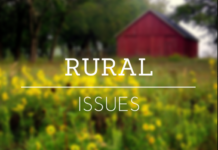LINCOLN, Neb. — A majority of rural Nebraskans are not worried about crime in their communities, and concerns about certain specific crimes, though still significant in some cases, have dropped in the last decade, according to the Nebraska Rural Poll.
Fifty-one percent of respondents said they are not worried or not very worried about crime in their community, and 63 percent said they are not worried or not very worried about personally being a victim of crime. Sixteen percent of rural Nebraskans said they are worried or very worried about crime in their community, and 12 percent are very worried or worried about personally being a victim.
Sixty-five percent of poll respondents this year agreed that drugs are a problem in their community; however, that’s down from 76 percent in 2003. The portion of respondents who agreed that juvenile delinquency is a problem in their community dropped from 51 percent in 2003 to 40 percent this year.
Twenty-one percent of rural Nebraskans said they feel safer in their community now than they did five years ago; in 2003, that percentage was 17 percent. Thirty-eight percent said they feel less safe.
The 19th annual University of Nebraska-Lincoln poll was sent to 6,813 households in 86 Nebraska counties in April. Results are based on 1,943 responses.
Nationally, most crime rates are down in the last decade, poll organizers said. That may be reflected in the poll’s findings. There are some differences by region.
Only 9 percent of rural residents of North Central Nebraska are worried or very worried about crime, compared to about 20 percent of residents of both the Panhandle and Southeast regions.
Panhandle residents also are more likely to say that various crimes are a problem in their communities, including drugs, juvenile delinquency and violent crime. For example, about three-fourths of Panhandle residents agree drugs are a problem, compared to 57 percent of residents of the North Central region.
Residents of South Central and Northeast Nebraska are more likely than those in other regions to agree gang activity is a problem; about 17 percent of respondents in those regions agreed with that statement, compared to only 4 percent in North Central and Southeast Nebraska.
Rural Poll organizers said concerns about crime in rural Nebraska may be on the rise in parts of western Nebraska near Colorado, where the legalization of marijuana already is increasing workloads for law enforcement in this state.
This issue has received a lot of media attention in the region, which may be linked to area residents’ increased awareness and concerns, said Cheryl Burkhart-Kriesel, associate professor and UNL Extension community vitality specialist based at the Panhandle Research and Extension Center.
Brad Lubben, UNL Extension policy specialist, said these issues may lead to some policy discussions in Nebraska, including debate about whether state or federal aid should go to law enforcement in western Nebraska to combat the problem.
Other findings:
– Thirty-one percent of respondents said they have a gun for protection; 27 percent said they have a dog for protection. These numbers don’t necessarily reflect the numbers of guns or dogs in households – only of the respondents who report having them specifically for protection.
– Six percent reported avoiding contact with people of another race out of a concern about crime.
– People living in or near larger communities are more likely than those in or near smaller communities to be worried or very worried about crime. Twenty-two percent of those near towns with populations of 10,000 or more are worried. Only 10 percent of those near towns of fewer than 1,000 share this concern.
– Older people are more likely than younger to be worried or very worried about crime, as are those with household incomes under $60,000, people with lower education levels, people without children in the household and people who have lived in their community for more than five years.
The Rural Poll is the largest annual poll of rural Nebraskans’ perceptions on quality of life and policy issues. This year’s response rate was about 29 percent. The margin of error is plus or minus 2 percent. Complete results are available online at http://ruralpoll.unl.edu.
With its 19-year history, the poll has a collection of data about rural trends and perceptions that is unmatched in the country, said Becky Vogt, survey research manager who’s been working on the Rural Poll since its second year.
Although the Grand Island area (Hall, Hamilton, Howard and Merrick counties) was designated a metropolitan area by the U.S. Census Bureau in 2013, the Rural Poll continues to include those counties in its sample. Also, Dixon and Dakota counties were added to the poll this year, meaning the poll reaches all of Nebraska outside the Omaha and Lincoln metropolitan areas.
The university’s Department of Agricultural Economics conducts the poll in cooperation with the Nebraska Rural Futures Institute with funding from UNL Extension and the Agricultural Research Division in the Institute of Agriculture and Natural Resources.




